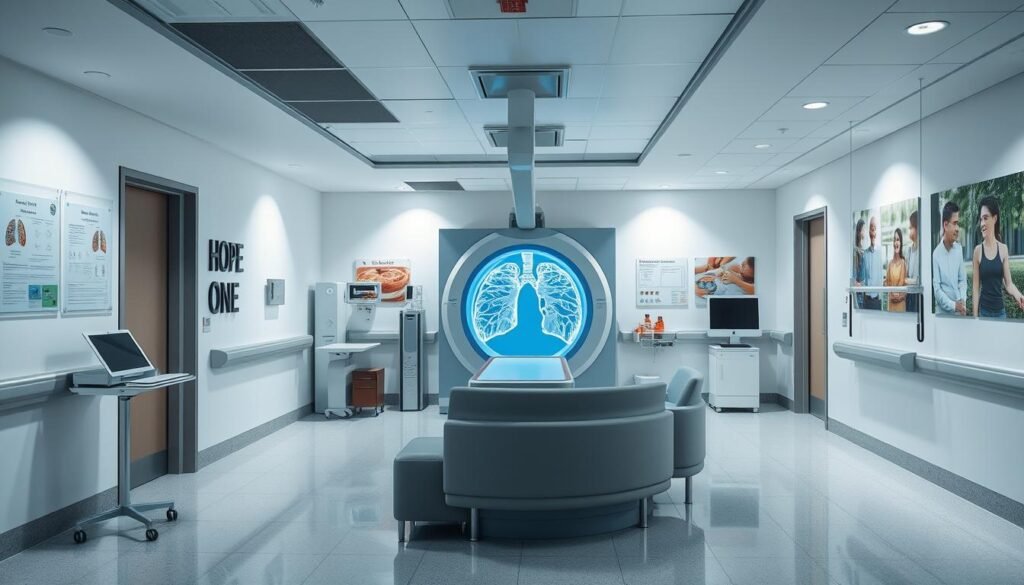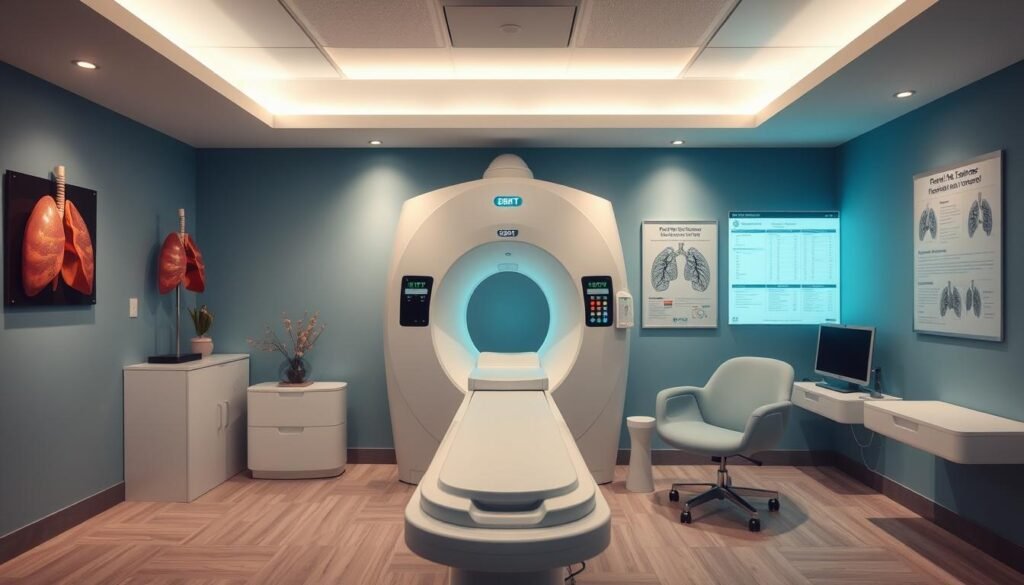Did you know Stereotactic Body Radiation Therapy (SBRT) can cure up to 90 percent of patients with early-stage lung cancer? In the past two decades, lung cancer treatment has changed a lot. Especially for those who can’t have surgery due to health issues. SBRT is different from old-school radiation. It doesn’t need many sessions over weeks. Instead, SBRT focuses radiation in just a few visits. This approach targets the tumor well and keeps the healthy tissue safe. Research shows that 95 percent of patients treated with SBRT are disease-free after three years. This makes SBRT a key player in advanced lung cancer treatment.
Nowadays, more patients and doctors see the value of SBRT in fighting lung cancer. We’ll explore how SBRT is making a huge difference. From what types of lung cancer it can treat to who can get it and the results it brings. You’ll get a full picture of this breakthrough therapy and its life-changing impact.
Key Takeaways
- SBRT can cure up to 90 percent of early-stage lung cancer patients.
- It offers rapid treatment compared to standard radiation techniques.
- Local control rates for SBRT patients can reach as high as 95 percent at three years.
- This therapy is recommended for patients unable to undergo surgery.
- SBRT minimizes side effects by precisely targeting tumor sites.
- Ongoing clinical trials continue to assess SBRT’s role in lung cancer treatment.
Understanding Lung Cancer and Its Types
Lung cancer is a major health issue with different types. Non-small cell lung cancer (NSCLC) and small cell lung cancer (SCLC) are the main kinds. It’s important to know about these to understand treatment and how to help patients better.
Types of Lung Cancer
Non-small cell lung cancer (NSCLC) is the most common type, making up about 84% of cases. It includes adenocarcinoma, squamous cell carcinoma, and large cell carcinoma.
- Adenocarcinoma
- Squamous cell carcinoma
- Large cell carcinoma
Small cell lung cancer (SCLC), on the other hand, is rarer but grows quicker. This makes its treatment more challenging. Knowing the differences helps in choosing the right treatment.
Statistics on Lung Cancer Prevalence
Lung cancer is the top cause of cancer deaths in the U.S. In 2014, it led to 159,260 deaths. In Missouri, there are about 5,370 new cases and 3,950 deaths each year.
About 15% of NSCLC cases are found early. With CT scans for those at high risk, we might find 33% early. Early detection is key. For early-stage NSCLC, surgery could greatly improve survival rates. This shows why we need to understand lung cancer well.
The Importance of Early Detection
Early detection is key to fighting lung cancer. If caught early, patients stand a much better chance at beating the disease. Screenings help find tumors early, improving chances of survival. Early diagnosis allows treatment when it’s most effective.
Benefits of Screening for Lung Cancer
Screening for lung cancer brings many benefits. These benefits make a big difference in patient care. Advantages include:
- Finding lung cancer early, even if there are no symptoms.
- Increasing survival rates through early-stage diagnosis and treatments.
- Enhancing treatment success and lowering long-term costs.
The rate of early-stage non-small cell lung cancer (NSCLC) is going up. This shows how vital screening is. Better early survival rates show that these programs are effective.
Challenges in Early Diagnosis
There are obstacles in early lung cancer detection. Often, patients don’t show symptoms early on. This leads to late detection. Relying just on symptoms can miss early treatment chances. Up to 25% of early-detected lung cancer patients can’t undergo surgery. It’s crucial to improve screening and diagnosis.
Improving screening can change patient outcomes significantly. It can also lower lung cancer death rates.

What is Stereotactic Body Radiation Therapy (SBRT) for Lung Cancer?
Steretactic Body Radiation Therapy, or SBRT, is a advanced lung cancer treatment. It delivers high doses of radiation precisely, protecting healthy tissues from harm. SBRT definition refers to a non-invasive method. It uses latest imaging to accurately target the tumor, improving cancer treatment significantly.
Defining SBRT and Its Mechanism
SBRT mechanism is all about precise image-guided radiation. It targets tumors with high-dose radiation in 1 to 8 sessions. It helps treat various cancers, especially lung. The planning session might take 2 to 4 hours. It includes marking the skin accurately for targeting. Each treatment is quick, taking about an hour, making it convenient for patients while being highly effective.
Differences Between SBRT and Traditional Radiotherapy
SBRT differs from traditional radiotherapy, which uses multiple, lower-dose treatments over weeks. SBRT’s focused, high-dose method shortens treatment time. It’s great for treating small, early-stage lung cancers. About 70% of early-stage patients do well with SBRT compared to usual therapy.
SBRT is not just for lung cancer. It’s used for tumors in the spine, liver, and beyond. How quickly it works varies. Benign tumors shrink slower than cancerous ones. If you’re considering SBRT, look into supplements for better recovery. Learn more here.
Eligibility for SBRT Treatment
Stereotactic body radiation therapy (SBRT) is a key treatment for lung cancer patients. It’s especially for those with certain conditions. Knowing if you’re eligible for SBRT is crucial. This helps decide the best treatment plan for lung cancer.
Who is a Good Candidate for SBRT?
People with early-stage non-small cell lung cancer (NSCLC) often qualify for SBRT. They can’t have surgery for several reasons. Factors for SBRT eligibility include:
- Presence of inoperable lung tumors
- Advanced age or serious other health issues
- A Karnofsky performance score of 50 or more
- Choosing not to have surgery based on personal reasons or medical advice
SBRT is great for those who can’t have normal surgery. It’s for patients with bad lung function or those surgery is too risky for. The American Society of Clinical Oncology (ASCO) sees SBRT as an option for patients who could have surgery but at high risk. This emphasizes its importance in cancer care.
Conditions That Render Surgery Inappropriate
Sometimes, surgery isn’t right for lung cancer patients. Situations include:
- Severe other health problems
- Big tumors or tumors near important body parts
- Unresectable tumors due to how far the cancer has spread
For example, SBRT suits node-negative Stage I and II NSCLC patients when surgery isn’t possible. SBRT can offer similar benefits in terms of controlling the cancer and survival rates. It avoids surgery risks. For more details and study outcomes, see the National Institutes of Health here.

Procedural Overview of SBRT
The SBRT treatment starts with a planning phase that is very important. Experts use imaging like CT scans to map the tumor and nearby areas. This step helps create a treatment plan specific to each patient’s needs.
Planning Phase of SBRT Treatment
Diverse imaging methods are used during planning to target the tumor accurately. It’s key to hitting the tumor precisely. Normally, SBRT gives 48 to 60 Gy in up to five sessions over two weeks. This method is great because it targets the illness but keeps healthy tissue safe. Checking the tumor’s position every day makes sure the treatment is right on target.
Technical Aspects: Image-Guided Radiation and Respiratory Gating
SBRT uses top-notch tech like image-guided radiation and respiratory gating. These help doctors track and adjust to tumor movement when you breathe. Using active breathing control (ABC) cuts down the chance of lung damage. If someone can’t use ABC, they can try holding their breath instead.
Thanks to these advanced techniques, SBRT has over a 90% success rate for treating a type of lung cancer. This is way better than older methods. This shows how critical accurate radiation is in fighting cancer.
Advantages of SBRT for Lung Cancer Patients
Stereotactic Body Radiation Therapy (SBRT) is quickly becoming a top choice for treating lung cancer. It delivers a high dose of radiation while keeping the patient safe, leading to fewer side effects. This makes it a leading treatment option in modern cancer care.
High-Dose Radiation Delivery with Minimal Side Effects
SBRT stands out by offering high-dose radiation that targets tumors accurately. It protects the healthy tissue around the tumor. About 80 to 90 percent of patients see success, much higher than the 30 to 40 percent with traditional methods. Also, fewer patients experience side effects like radiation pneumonia, thanks to the precise targeting of radiation.
Rapid Treatment Times and Patient Convenience
SBRT makes treatment quick and convenient. Patients often finish treatment in one to two weeks, unlike the longer six to eight weeks for traditional therapy. They usually have 3 to 5 sessions, which fits easily into their daily lives. This quick schedule helps patients recover faster, an important aspect when fighting cancer.
| Feature | SBRT | Conventional Radiation Therapy |
|---|---|---|
| Success Rate | 80-90% | 30-40% |
| Treatment Sessions | 3-5 | 30+ (Daily) |
| Treatment Duration | 1-2 weeks | 6-8 weeks |
| Radiation Dose | High-Dose | Standard |
| Common Side Effects | Fewer | More |
Clinical Outcomes Associated with SBRT
Stereotactic Body Radiation Therapy (SBRT) holds great potential for lung cancer patients. It shows positive results in lung cancer survival rates. This is especially true for those with early-stage non-small cell lung cancer (NSCLC). The two- and five-year local control rates for NSCLC patients treated with SBRT are impressive at 94.4%.
Survival Rates and Local Control Statistics
Further analysis of SBRT clinical outcomes shows a two-year cancer-specific survival rate of 94.6%. By the five-year mark, this number slightly declines to 90.8%. Additionally, progression-free survival rates are at 69.0% and 43.3% after two and five years.
The overall survival rates are 80.0% and 59.3% for the same periods. Tumor progression, histology, and T stage are closely linked to survival rates. Following treatment, local, regional, and distant recurrences were observed in 11 patients.
Comparison with Other Treatment Options
SBRT is proving to be effective when compared to traditional radiation therapy. It achieves similar two-year local control and overall survival rates. The side effects of SBRT are few, with minor cases of grade 3 radiation pneumonitis. Notably, there were no severe grade 4 or 5 side effects. The median follow-up time for patients was 50 months.
For further details on lung cancer differences, visit this resource. It will help you understand how these differences affect treatment results.
Potential Side Effects and Management
Stereotactic body radiation therapy (SBRT) is a strong treatment for lung cancer. It has great benefits. However, it’s essential to know about possible side effects. These include fatigue, skin reactions, and sometimes serious conditions like pneumonitis. Spotting these early helps in managing them better.
Common Side Effects of SBRT
People getting SBRT might face various side effects. How severe these effects are can differ from person to person. Most common issues are:
- Fatigue
- Nausea
- Vomiting
- Skin changes, such as redness or irritation
- Damage to organs close by, like lungs and esophagus
Radiation on the brain might cause headaches, memory loss, or thinking problems. Knowing these complications helps in taking better care of lung cancer patients.
Strategies for Mitigating Side Effects
Managing side effects well is key to keeping a good quality of life. Some strategies are:
- Teaching patients about the side effects they might see
- Checking regularly to catch symptoms early
- Adding support like nutrition help and rehab
- Talking with patients about their health and side effect management
With these strategies, medical teams can support patients better during treatment. Patients should talk to their doctors to tailor side effect management plans. For in-depth knowledge on SBRT and its effects, visit this detailed overview.

Conclusion
Stereotactic Body Radiation Therapy (SBRT) has changed lung cancer treatment. It offers a new option for patients who can’t undergo surgery. With success rates over 90% for early lung cancer, it’s a top choice. SBRT’s quick treatment time and fewer side effects make it stand out.
Research on SBRT is making lung cancer care better. Studies are ongoing to improve how we use SBRT. This will ensure treatments are customized for each patient. This approach increases the success of SBRT in treating lung cancer.
SBRT is proven to be effective, with high success rates and low severe toxicity. Doctors are working hard to unlock its full potential. This means lung cancer treatments will become more effective and easier for patients.